What Causes Monsoons?
A COMMON MISCONCEPTION is that the word “monsoon” refers to a type of rainfall, but the word actually refers to winds that reverse directions depending on the season. One of these seasonal wind directions typically brings dry conditions and the other brings wet conditions. Monsoons impact a majority of the world's population.
What Are the Features of the Asian Monsoon?
One way to characterize a monsoon is to compare maps showing wind directions for different times of the year. Such maps can then be compared to rainfall records to determine which seasonal wind directions bring dry conditions and which ones bring wet conditions. The maps below show climatological wind conditions for the years 1981 through 2010 for two months — January and July. Arrows show wind directions, and shading represents pressure at sea level, with light gray being high and dark gray being low. Examine the patterns of circulation for each month and then compare the patterns between the months.
January — This map shows typical wind conditions for Asia during January. In the center of the map, winds define a region where flow is clockwise and outward, centered on the light-colored area of high pressure. This high-pressure area (anticyclone) forms from cold, sinking air over Siberia. This circulation brings very dry air (from the cold interior of the continent) from the north over southern Asia and from the northwest across eastern Asia. We would predict from these wind patterns that little precipitation would occur in much of Asia at this time.

July — This map shows that wind conditions for the same region during July are totally different than they are for January. Circulation that marked the high pressure is gone, replaced by an area of inward and counterclockwise flow over Tibet (north of Kolkata). In the Northern Hemisphere, this pattern of circulation is diagnostic of a low-pressure area, which in this case is caused by warm, rising air that accompanies warming of the Asian landmass. This circulation brings very humid air from the southwest over southern and southeastern Asia. How do you think this circulation affects rainfall?

Seasonal Variation in Precipitation
Observe these graphs showing average monthly precipitation amounts for two very different parts of Asia: Kolkata, one of the largest metropolitan areas of India, and Seoul, the capital of South Korea. For both cities, notice prominent precipitation peaks that occur during the summer — the wet season. The increase in precipitation during the wet season results from the flow of moist air from oceans onto land, toward the Tibetan Low. The dry season, during the winter months, reflects the flow of dry air from the land, flowing outward from the Siberian High.
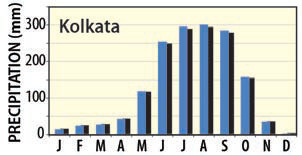
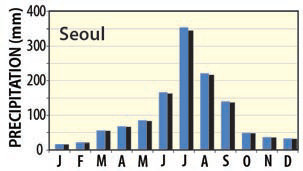
Effect of the Monsoon on Vegetation
These satellite images show increased vegetation due to monsoonrelated rains along the western coast of India. The left image is during the dry season, when wind patterns bring in dry air. The right image is from the end of the monsoon. Note the increase in plant cover (green areas) during the monsoon-caused rainy season.


What Other Regions Experience Monsoon Circulations?
West Africa
January — In January, near-surface winds in West Africa largely flow from the northeast bringing in dry air from inland areas, including the Sahara Desert, and carrying it southwest to coastal areas and farther offshore. Such offshore flows generally result in dry weather.
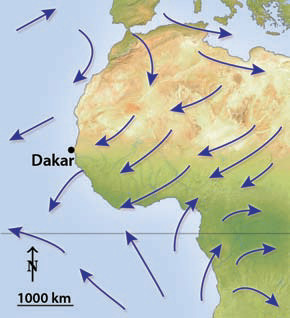
July — A shift in wind direction in July brings moist ocean air from several directions onto the very hot land where air has risen This change in wind direction causes enormous differences in precipitation, as shown by the graph below for Dakar, Senegal. Along with the increase in precipitation comes an increase in the amount of vegetation. In Dakar and much of the region, precipitation is nearly nonexistent in January and adjacent months.
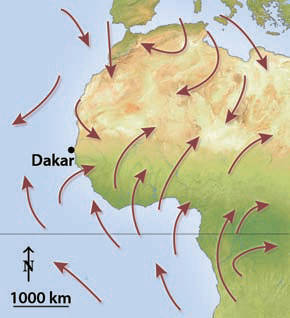
Northern Australia
January — In January (the southern summer), winds over northern Australia bring moist air from the ocean onto the heated land surface.
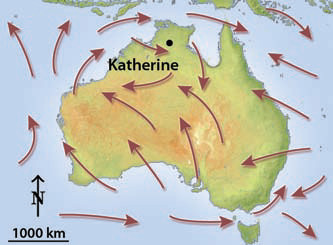
July — The wind shifts by July (winter) as the land surface cools, creating higher pressure over the land. This causes a large drop in precipitation, as shown by the graph below for Katherine, Australia. The monsoon flow in January results in plentiful rain.

Southwestern U.S.
January — Southwestern North America, most of which is desert, has a less dramatic, but still important monsoon effect. In the winter months, winds blow from various directions, and winter precipitation in this region is from brief incursions of cold, wet air (i.e., cold fronts) from the northwest.

July — During the late summer months, heating of the land surface and the resulting low pressure causes a shift in winds. Winds from the south bring moist air northward from the Gulf of Mexico and Gulf of California, and summer thunderstorms from when this air interacts with the heated land. These summer thunderstorms cause precipitation to peak in August, as shown by the graph below for Tempe, Arizona. First, note the different scale needed to show the relatively small amounts of precipitation. Also note that nearly as much precipitation falls in the winter from the cold fronts.

The Effect of Monsoons on Cultures
Monsoons greatly influence the lives of people living in regions with seasonal shifts in wind. The main effects of a monsoon are seasonal variations in precipitation, which in turn affect water supplies, amount of vegetation, and overall livability for some normally dry landscapes. Many cultures plan their activities around these seasonal changes, conserving water during the dry season and taking advantage of the plentiful water during the wet season. The monsoon pervades the psyches of people in southern and southeastern Asia, especially the region from India to Vietnam, in ways not fathomable to most North Americans or Europeans. The influence on agriculture, including the cultivation of rice, and on flooding and other natural hazards is obvious, but the monsoon also appears in literature, art, music, architecture, and nearly every other aspect of culture. Ceremonies commonly mark the anticipated start of the monsoon. In years when the monsoon rains arrive later than usual, people become very concerned that harvests will suffer. The date of the onset of the monsoon rains varies by location, but generally proceeds from south to north with the onset in April and May.